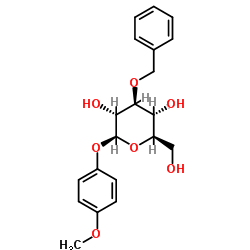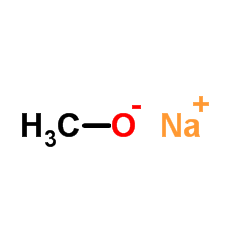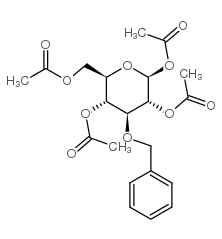303127-80-2
| Name | (2R,3R,4S,5R,6S)-2-(hydroxymethyl)-6-(4-methoxyphenoxy)-4-phenylmethoxyoxane-3,5-diol |
|---|---|
| Synonyms |
4-Methoxyphenyl 3-O-benzyl-β-D-glucopyranoside
4-Methoxyphenyl 3-O-Benzyl-beta-D-glucopyranoside M1641 β-D-Glucopyranoside, 4-methoxyphenyl 3-O-(phenylmethyl)- |
| Description | 4-Methoxyphenyl 3-O-Benzyl-β-D-glucopyranoside is a biochemical reagent that can be used as a biological material or organic compound for life science related research. |
|---|---|
| Related Catalog |
| Density | 1.3±0.1 g/cm3 |
|---|---|
| Boiling Point | 599.2±50.0 °C at 760 mmHg |
| Molecular Formula | C20H24O7 |
| Molecular Weight | 376.400 |
| Flash Point | 316.2±30.1 °C |
| Exact Mass | 376.152191 |
| PSA | 97.61000 |
| LogP | 2.97 |
| Vapour Pressure | 0.0±1.8 mmHg at 25°C |
| Index of Refraction | 1.613 |
|
Section I.Chemical Product and Company Identification Chemical Name 4-Methoxyphenyl 3-O-Benzyl-beta-D-glucopyranoside Portland OR Synonymbeta-D-Glucopyranoside, 4-methoxphenyl 3-O-(phenylmethyl)- (9CI) Chemical FormulaC20H24O7 CAS Number303127-80-2
Section II.Composition and Information on Ingredients Toxicology Data Chemical NameCAS Number Percent (%)TLV/PEL Min. 98.0 Not available.Not available. 4-Methoxyphenyl 3-O-Benzyl-beta-D-glucopyranoside 303127-80-2 (HPLC) Section III. Hazards Identification Acute Health EffectsNo specific information is available in our data base regarding the toxic effects of this material for humans. However, exposure to any chemical should be kept to a minimum. Skin and eye contact may result in irritation. May be harmful if inhaled or ingested. Always follow safe industrial hygiene practices and wear proper protective equipment when handling this compound. Chronic Health EffectsCARCINOGENIC EFFECTS : Not available. MUTAGENIC EFFECTS : Not available. TERATOGENIC EFFECTS : Not available. DEVELOPMENTAL TOXICITY: Not available. Repeated or prolonged exposure to this compound is not known to aggravate existing medical conditions. Section IV.First Aid Measures Eye ContactCheck for and remove any contact lenses. In case of contact, immediately flush eyes with plenty of water for at least 15 minutes. Get medical attention. Skin ContactIn case of contact, immediately flush skin with plenty of water. Remove contaminated clothing and shoes. Wash clothing before reuse. Thoroughly clean shoes before reuse. Get medical attention. If the victim is not breathing, perform mouth-to-mouth resuscitation. Loosen tight clothing such as a collar, tie, belt or Inhalation waistband. If breathing is difficult, oxygen can be administered. Seek medical attention if respiration problems do not improve. INDUCE VOMITING by sticking finger in throat. Lower the head so that the vomit will not reenter the mouth and throat. Ingestion Loosen tight clothing such as a collar, tie, belt or waistband. If the victim is not breathing, perform mouth-to-mouth resuscitation. Examine the lips and mouth to ascertain whether the tissues are damaged, a possible indication that the toxic material was ingested; the absence of such signs, however, is not conclusive. Section V.Fire and Explosion Data Not available. May be combustible at high temperature.Auto-Ignition Flammability Flash PointsFlammable LimitsNot available. Not available. These products are toxic carbon oxides (CO, CO2). Combustion Products Fire HazardsNot available. Risks of explosion of the product in presence of mechanical impact: Not available. Explosion Hazards Risks of explosion of the product in presence of static discharge: Not available. Fire Fighting Media SMALL FIRE: Use DRY chemical powder. LARGE FIRE: Use water spray, fog or foam. DO NOT use water jet. and Instructions Consult with local fire authorities before attempting large scale fire-fighting operations. Continued on Next Page 4-Methoxyphenyl 3-O-Benzyl-beta-D-glucopyranoside Section VI.Accidental Release Measures Spill CleanupUse a shovel to put the material into a convenient waste disposal container. Finish cleaning the spill by rinsing any contaminated surfaces with copious amounts of water. Consult federal, state, and/or local authorities for assistance on Instructions disposal. Section VII. Handling and Storage Handling and StorageFREEZE. Keep away from heat. Mechanical exhaust required. When not in use, tightly seal the container and store in a dry, cool place. Avoid excessive heat and light. Do not breathe dust. Information Always store away from incompatible compounds such as oxidizing agents. Section VIII. Exposure Controls/Personal Protection Use process enclosures, local exhaust ventilation, or other engineering controls to keep airborne levels below recommended Engineering Controls exposure limits. If user operations generate dust, fume or mist, use ventilation to keep exposure to airborne contaminants below the exposure limit. Splash goggles. Lab coat. Dust respirator. Boots. Gloves. Suggested protective clothing might not be sufficient; consult a Personal Protection specialist BEFORE handling this product. Be sure to use a MSHA/NIOSH approved respirator or equivalent. Exposure LimitsNot available. Section IX. Physical and Chemical Properties Solid.Solubility Physical state @ 20°CNot available. Not available. Specific Gravity 376.4 Molecular WeightPartition CoefficientNot available. Boiling PointNot available.Vapor PressureNot applicable. 141 to 146°C (285.8 to 294.8°F)Not available. Melting PointVapor Density Not available.VolatilityNot available. Refractive Index Not available. Critical TemperatureNot available.Odor ViscosityNot available.TasteNot available. Section X.Stability and Reactivity Data Stability This material is stable if stored under proper conditions. (See Section VII for instructions) Conditions of InstabilityAvoid excessive heat and light. Incompatibilities Reactive with oxidizing agents. Section XI. Toxicological Information Not available. RTECS Number Routes of ExposureEye Contact. Ingestion. Inhalation. Not available. Toxicity Data Chronic Toxic EffectsCARCINOGENIC EFFECTS : Not available. MUTAGENIC EFFECTS : Not available. TERATOGENIC EFFECTS : Not available. DEVELOPMENTAL TOXICITY: Not available. Repeated or prolonged exposure to this compound is not known to aggravate existing medical conditions. Acute Toxic EffectsNo specific information is available in our data base regarding the toxic effects of this material for humans. However, exposure to any chemical should be kept to a minimum. Skin and eye contact may result in irritation. May be harmful if inhaled or ingested. Always follow safe industrial hygiene practices and wear proper protective equipment when handling this compound. Section XII.Ecological Information Not available. Ecotoxicity Not available. Environmental Fate Continued on Next Page 4-Methoxyphenyl 3-O-Benzyl-beta-D-glucopyranoside Section XIII. Disposal Considerations Waste DisposalRecycle to process, if possible. Consult your local regional authorities. You may be able to dissolve or mix material with a combustible solvent and burn in a chemical incinerator equipped with an afterburner and scrubber system. Observe all federal, state and local regulations when disposing of the substance. Section XIV. Transport Information Not a DOT controlled material (United States). DOT Classification PIN NumberNot applicable. Proper Shipping NameNot applicable. Packing Group (PG)Not applicable. DOT Pictograms Section XV. Other Regulatory Information and Pictograms TSCA Chemical InventoryThis product is NOT on the EPA Toxic Substances Control Act (TSCA) inventory. The following notices are required by 40 CFR 720.36 (C) for those products not on the inventory list: (EPA) (i) These products are supplied solely for use in research and development by or under the supervision of a technically qualified individual as defined in 40 CFR 720.0 et sec. (ii) The health risks of these products have not been fully determined. Any information that is or becomes available will be supplied on an MSDS sheet. WHMIS ClassificationNot available. (Canada) EINECS Number (EEC)Not available. EEC Risk StatementsNot available. SECTION 16 - ADDITIONAL INFORMATION N/A |
|
~87% 
303127-80-2 |
| Literature: Karst, Nathalie; Jacquinet, Jean-Claude Journal of the Chemical Society, Perkin Transactions 1, 2000 , # 16 p. 2709 - 2717 |
|
~% 
303127-80-2 |
| Literature: Tetrahedron, , vol. 60, # 35 p. 7755 - 7766 |
|
~% 
303127-80-2 |
| Literature: Journal of the Chemical Society, Perkin Transactions 1, , # 16 p. 2709 - 2717 |
|
~% 
303127-80-2 |
| Literature: Journal of the Chemical Society, Perkin Transactions 1, , # 16 p. 2709 - 2717 |
| Precursor 4 | |
|---|---|
| DownStream 1 | |




